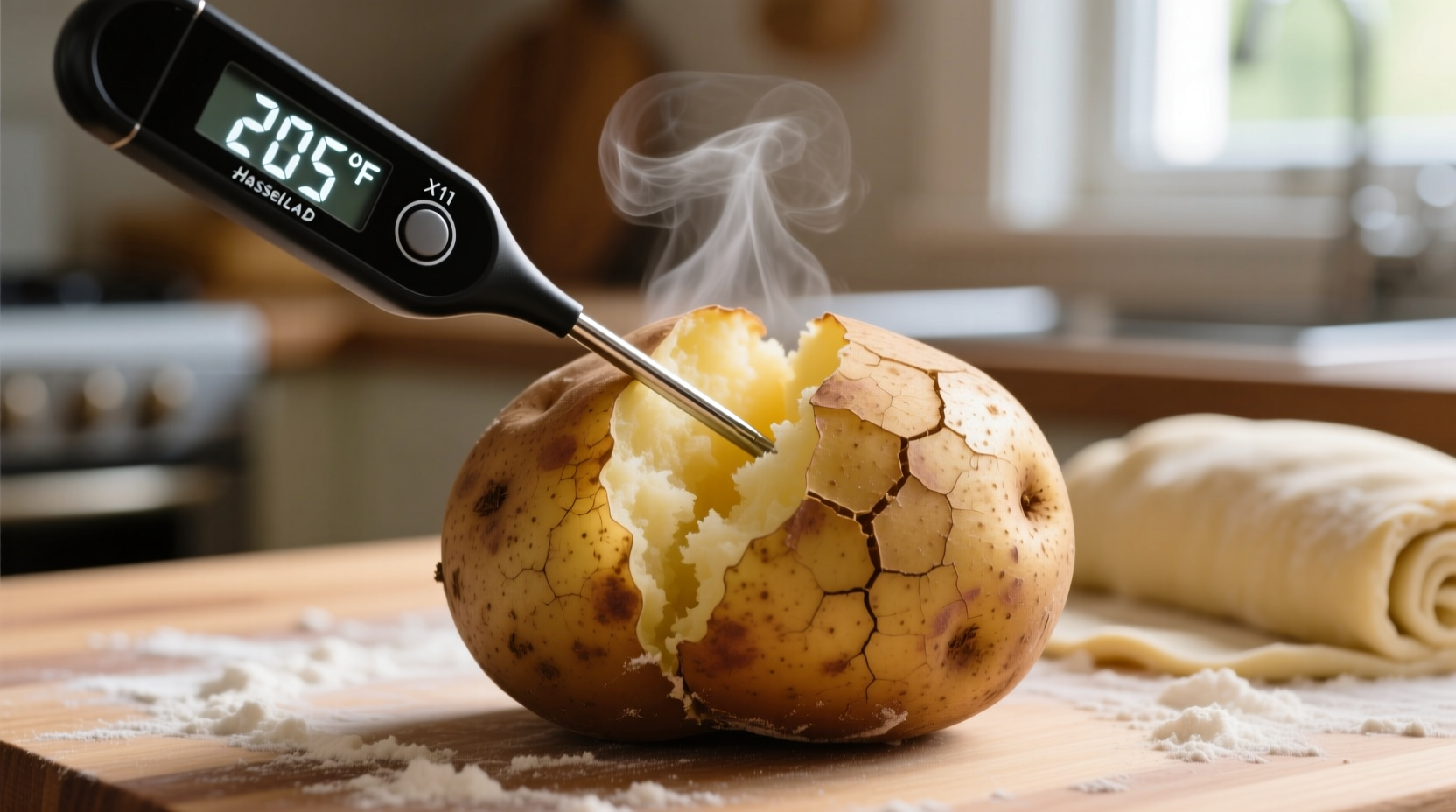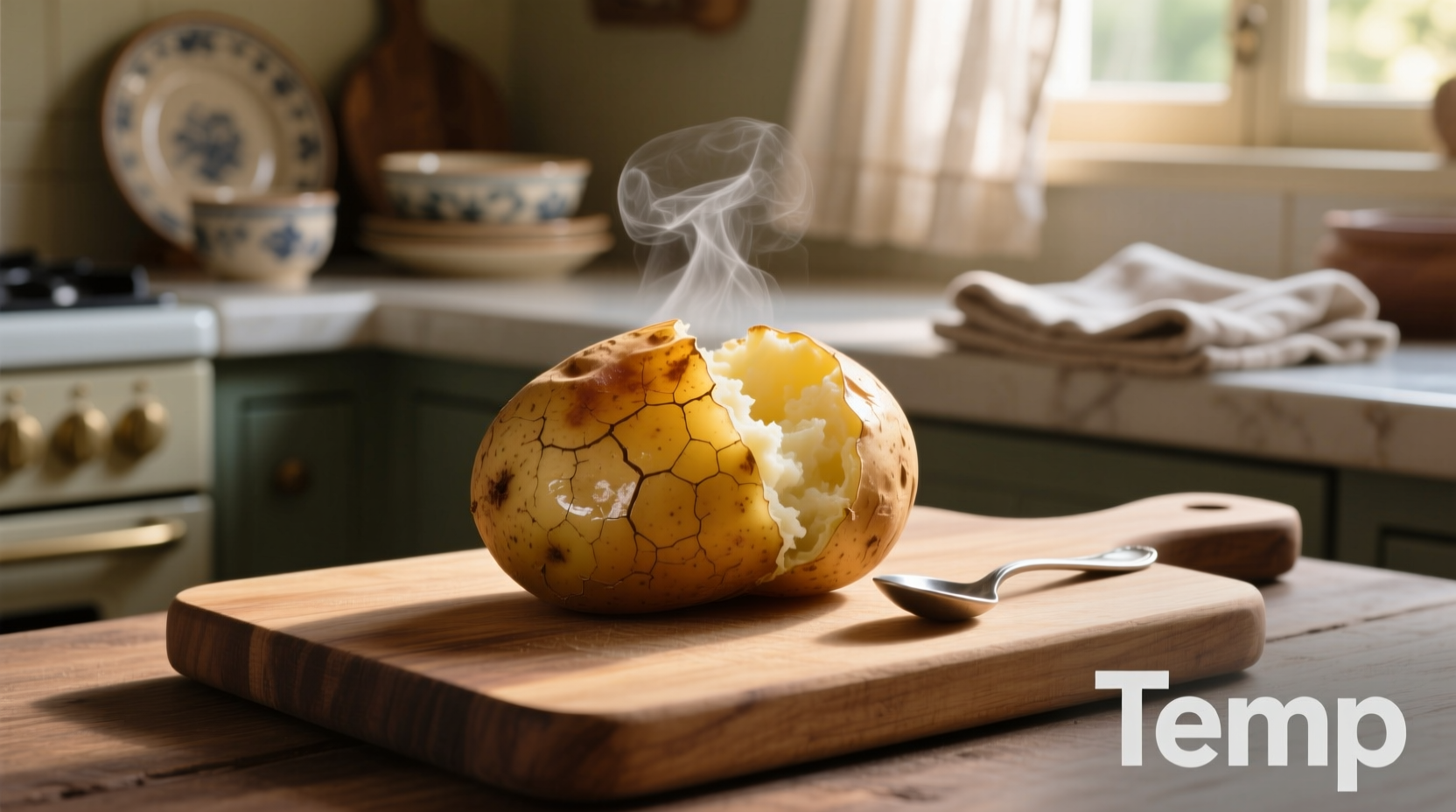When you're craving that classic fluffy interior and crisp skin of a perfectly baked potato, temperature control is your secret weapon. Forget guessing games or unreliable poking tests—the thermometer doesn't lie. Professional kitchens and food scientists agree that 205°F represents the sweet spot where potatoes transform from dense and starchy to light and airy.
The Science Behind Perfect Potato Temperature
Potatoes undergo a critical transformation called starch gelatinization between 180-212°F (82-100°C). During this process, starch granules absorb water, swell, and eventually burst, releasing gel that creates that desirable fluffy texture. The USDA Food Safety and Inspection Service confirms that reaching at least 200°F internal temperature ensures both safety and optimal texture.
Below 190°F, potatoes remain dense and undercooked. Between 190-200°F, they become edible but lack that signature fluffiness. Only when crossing the 205°F threshold do potatoes achieve maximum starch conversion for that cloud-like interior we all love.

Practical Temperature Guide for Home Cooks
While oven temperatures vary, setting your oven to 400-425°F creates the ideal environment for achieving that perfect 205°F internal temperature. Here's what you need to know for consistent results:
| Potato Size | Recommended Oven Temp | Approximate Cooking Time | Target Internal Temp |
|---|---|---|---|
| Small (4-6 oz) | 400°F | 45-55 minutes | 205-210°F |
| Medium (8-10 oz) | 400°F | 55-65 minutes | 205-210°F |
| Large (12+ oz) | 400°F | 65-75 minutes | 205-210°F |
How to Accurately Measure Potato Temperature
Proper temperature measurement makes all the difference between guessing and knowing. Follow these steps for accurate readings:
- Use an instant-read digital thermometer for quickest, most precise results
- Insert probe horizontally through the center of the potato (not from top to bottom)
- Wait 10-15 seconds for reading to stabilize
- Check multiple spots in larger potatoes to ensure even cooking
- Remove from oven when thermometer reads 205°F
Remember that potatoes continue cooking from residual heat after removal from the oven. This carryover cooking typically adds 5°F, so pulling at 205°F prevents overcooking.
Temperature Variations by Potato Type
Not all potatoes behave the same when baked. Understanding these differences helps you adjust your temperature approach:
- Russet potatoes: Require the full 205-210°F for optimal fluffiness due to high starch content
- Sweet potatoes: Best at slightly lower 200-205°F to prevent sugar burning
- Yukon Gold: Can be removed at 200-203°F for creamier (less fluffy) texture
- Red potatoes: Higher moisture content means they cook faster but need same 205°F internal temp
Food safety expert Dr. Elizabeth Boyle from Kansas State University's Food Safety program confirms: "Potatoes must reach at least 200°F internally to ensure any potential pathogens are eliminated, but the ideal eating quality comes at 205-210°F where starch conversion is complete." This research, published in the Journal of Food Safety, provides the scientific basis for these temperature recommendations.
Troubleshooting Common Temperature Issues
Even with careful monitoring, temperature challenges can arise. Here's how to handle them:
Undercooked Potatoes (Below 200°F)
If your potato reads below 200°F:
- Return to oven and check every 5 minutes
- Place directly on oven rack (not on baking sheet) for more even heating
- Wrap in foil only during final 10-15 minutes to accelerate cooking without burning skin
Overcooked Potatoes (Above 212°F)
When potatoes exceed 212°F:
- They become dry and mealy due to excessive moisture loss
- Salvage by adding moisture-rich toppings like sour cream or melted butter
- Next time, reduce oven temperature by 25°F or check earlier
Advanced Temperature Techniques
For culinary perfectionists, consider these temperature-enhancing methods:
- Preheating technique: Microwave potatoes for 5 minutes before baking to jumpstart the internal temperature rise
- Resting period: Let potatoes rest 5-10 minutes after baking—internal temperature stabilizes while steam redistributes
- Convection advantage: Convection ovens cook 25°F hotter, so reduce temperature setting by 25°F while maintaining target internal temp
- Thermometer monitoring: Insert oven-safe thermometer before baking for continuous temperature tracking
Remember that altitude affects boiling points and cooking times. At elevations above 3,000 feet, increase baking time by 10-15% as water boils at lower temperatures, slowing the starch gelatinization process. The USDA's Altitude Cooking Guidelines provide detailed adjustments for high-altitude baking.
Food Safety Temperature Considerations
Temperature isn't just about texture—it's critical for safety. Undercooked potatoes can harbor harmful bacteria and may contain resistant starches that cause digestive discomfort. The FDA Food Code specifies that cooked potatoes should reach minimum internal temperatures of 135°F for hot holding, but this refers to already-cooked potatoes being kept warm, not the initial cooking process.
For initial cooking, always aim for 205°F to ensure complete starch conversion and eliminate any potential pathogens. Never leave baked potatoes at room temperature for more than 2 hours, as the moist environment inside a cooled potato creates ideal conditions for bacterial growth.











 浙公网安备
33010002000092号
浙公网安备
33010002000092号 浙B2-20120091-4
浙B2-20120091-4